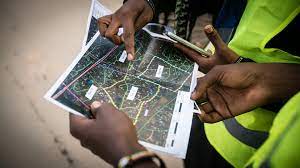Lingkar Temu Kabupaten Lestari is an association of district governments formed and managed by district governments to achieve sustainable development that protects the environment and improves community welfare through mutual cooperation.
Ristika Putri Istanti and Adinda Aksari spoke with Ambika Samarthya-Howard on July 1, 2025. Click here to read the full conversation with insights highlighted.
Ambika Samarthya-Howard: Tell me more about your organization and your approach.
Ristika Putri Istanti: Thank you. I want to introduce my team. Adinda Aksari is the Deputy Head of Institutional Building from the Secretariat, and Andri is from our partnership team. Since 2023, I have been transitioning into the role of Head of Secretariat at LTKL (Sustainable District Association) In Indonesia, we have many collective action platforms, but we have built a different model. There are three authorities: national, provincial, and district. We are at the district government; we have nine districts across Indonesia. The country has more than 400 districts, so we only cover 1%.
We were established in 2017, and Adinda, Andri, and I, as the secretariat, are bridge builders, not implementers. We have members from the district governments, not embedded in the political parties or on the executive level, but as part of the ecosystem at the district level.
Currently, we have 25 main partners, but across our district, we collaborate with more than 100 implementer partners on the national and local level on how to build a strategy as a sustainable district.
Ambika Samarthya-Howard: How did you choose those partners? How do they work with each other? My understanding is that the partners work together, and you facilitate that.
Ristika Putri Istanti: The most important thing is that we have to know our north star first. What’s the goal? The second step is to understand their needs. Who are the people that we convince? We have to ensure how to build a sustainable district. We have to understand the needs from the district’s perspective to ensure that the Secretariat is not biased. Maybe the district needs capacity building for the policy, but what type of policy?
We need to validate between the LTKL goals, the organizational goals, and the district goals.
We try to cultivate the partner based on the needs and the goal of our organization and districts. At the beginning, we had more than 200, and we had to curate the processes with strict indicators to ensure the local approach.
We tried for almost seven years, and we found that the type of approach is a fundamental factor for collaboration with partners. They can deliver some of the products or interventions, but if they come with an urban-centric approach, it might not be suitable for the district model.
I never imagined it in the beginning, but we realized that the secretariat must understand its “bias.” Firstly, we need to validate the district’s needs. Our main job is to ensure that the district can increase or improve its performance around policy and planning, multi-stakeholder processes, data governance, and sustainable businesses. The secretariat had to be convinced about the district’s incentives to improve its performance.
It’s not only about the money, but also about the network, capacity, and exposure. We built an unlikely partnership between the districts. We’re currently revamping our partnerships model, which is not easy with so many types of partners and interests.
Ambika Samarthya-Howard: Are all these partners taking a small piece of the puzzle? Somebody works with youth, somebody works with cattle, somebody works with women, somebody works with the environment, or is it all of you working on one thing? How do the partners make up a whole?
Ristika Putri Istanti: We have a main partner with whom we build the annual strategy. A few weeks ago, we collaborated with all the district members, the district governments, and all the main national and local partners. We collaborate, imagine, and evaluate one year back and one year ahead.
Our job is to convince them to build the strategic program for the district. The second layer — once they agree on the strategic program — is to understand what we need to achieve in the next years and find the gap.
Ambika Samarthya-Howard: Can you tell me an example of a recent gap that you found?
Ristika Putri Istanti: I’m currently in West Kalimantan in one of our districts, Sintang. A few weeks ago, we built the strategic program from the LTKL perspective, and then we trickled it down to all nine district members. It’s best if they have targets to contribute to LTKL’s goals, build the program, and see how to achieve these goals.
Based on the perspectives of the district and the partners, we make up part of the program.
The LTKL goals for 2030 are to ensure that the district can protect 50% of the forest and important ecosystems, and improve the welfare of almost one million communities. The question is how the district can contribute to this organization’s goal because we are a collective forum. A few weeks ago, they gave a one-year target for 2026 and developed the programs.
How to achieve the goal, and how can the partners join and be involved in each district? Some partners don’t have any projects or programs in the district, so they can use their expertise to come into the district. In each district, we have a collective action map with the goals of the district and the goals from the partners already working there, and how many resources they have and where they work. To ensure there’s no overlap project.
All the district members have the collective action map. Sintang in West Kalimantan is one of the more advanced districts, with 45 partners’ contributions. They have an innovative program, “unboxing day,” where they invited all the partners to go through the district government’s five-year planning documents and do the alignment and shared contribution.
Maybe there is some in-kind contribution from the partners, and then they can fill in the gap. We can help the district to convince partners to bridge the gap; how many resources do they have? How many years? Where are the locations? After that, the partner’s contribution is counted annually, not only for the Grassroots Support Organization (GSO) or the development partner, but also for the private sector.
Ambika Samarthya-Howard: About the work you do with district governments, I know that you recently partnered with the APKASI, the Indonesian Association of District Governments (Asosiasi Pemerintah Kabupaten Seluruh Indonesia). In Brazil, there are legal frameworks for criminality, and the environmental legislations are framed in a different legal system. Is that what’s happening here with these different levels of government?
Ristika Putri Istanti: In Indonesia, for two decades, we’ve had national regulations about decentralization. In the current situation, the district doesn’t have much authority.
The forest, the energy, and the investment are controlled by the national government. Our strategy is to convene at the provincial level, where many mandates and authorities go to right now. It’s not for all the district members. We have an annual general assembly with a performance review for the district members. Our approach is collective action.
Our member is our district government, but the district government must convince the other stakeholders because it cannot implement this model by itself. We engage with the provincial level in West Kalimantan, because three of our district members are located there.
We have an agreement with the provincial level on how to bridge this model to the national level, instead of going directly from the district level to the national level. In Central Sulawesi province, we connected similarly on how the national goal goes to the provinces and districts.
We have to build a bottom-up approach from the model they’ve already built in the district. For example, the province of West Kalimantan, with Sintang, has many innovations and multi-stakeholder collaborations. The Indonesian national government cut off 50% of the national budget for the district government. Sintang has a scheme on what the partners can help them contribute to for their shared goal. We’re currently working on this with them.
With APKASI, we collaborate to explore how this learning can be replicated in other districts beyond LTKL members, as part of our scaling strategy.
Ambika Samarthya-Howard: What’s been your challenge? What is the biggest advice you have for people doing this work, or the biggest barriers you’d face?
Adinda Aksari: That’s a very hard question. One thing that comes to mind is related to my role as a deputy head of the Institutional Building. I organize the organizations, design how people interact with each other, and how the organizations react to it. One of the biggest challenges is building relationships with all of the people in place, in the districts, at the national level, and the youth who are part of the ecosystem.
It comes back to the nature that everyone is human with hopes and challenges, and comes from their own interests. I always joke that LTKL is like a matchmaker between the bride and groom. Our hardest job is understanding the interests, characteristics, and needs of the people, even though they don’t recognize their needs.
As an experienced matchmaker, the most important thing is to build relationships. We have to understand the characters and the people behind them. In the beginning, there were lots of perceptions between the local NGOs and the private sector about the local government being too bureaucratic and hard to deal with. The local government also perceives them as rule breakers.
Our role is to build trust, introduce a project, collaborate, and then see what good can happen after that, one project to another. In my five years working with LTKL, I can see how the change has been heartwarming.
When I visited Sigi five years ago, one of our districts in Central Sulawesi, I never imagined that our local government would listen to what the youth wants. Today, the youth themselves built coalitions and institutions to provide direct impact for the local government that sees them as important actors who contribute significantly and evidently.
This youth group becomes a part of their policymaking. One of the things I’m most proud of is LTKL building a legacy of changing the way a landscape should be organized, by recognizing that a large area cannot be managed by one person but should be managed together, in synergy, from one project to another.
Ristika Putri Istanti: If we imagine a stage, our role is like an orchestrator. We have to be ready to be unseen and unrecognized because, as a convener, people will misinterpret your role. We have to ensure the stage is ready; who are the people who can play the drums, and who can be the singer.
Secondly, we have to understand that our job as the convener is complex, and we need to build practical pathways to give explanations to many types of stakeholders.
We have many different conversations with the government, the GSO, and the youth. We need to adjust our roles and identify the people we want to talk to. It’s not only about capacity; it’s also about capability and how to understand ourselves.
Ambika Samarthya-Howard: This idea of convening systems change is important. Why is this specifically relevant in the Indonesian and climate context? How are you working in systems and doing this orchestration work with climate?
Adinda Aksari: That’s an interesting question. The challenges in terms of climate actions everywhere in the world are quite the same, where people are conflicting about resources. What we are doing to unlock the conflict is to not bring it into ecosystems, but to make it more relatable.
For instance, in Indonesia, the biggest issue is the need to secure food and nutrition, and clean air, because we are battling a visible pollution crisis. The government keeps talking about food estates. We are also seeing feasible dangers from disasters like constant flooding. Farmers can’t plant rice or other crops according to the seasons, because there are no seasons at the moment. It keeps changing.
We don’t force them to understand that we have to protect the forest, or see this as a climate crisis. We bring it into more grounded words. In Sigi, for example, we have seen the impact of a massive earthquake that brings up liquefaction from the ground.
Another example is Sintang, where Ristika Putri Istanti is at the moment, in Central Kalimantan. They frequently experience major floods and realize it’s not about protecting the forest, it is about protecting them and the economy. If this happens again and again, it could cause a major problem. The economy stops, and their way of life stops because of those problems. Even the national government sees and feels the impact of the disaster.
Andri Cahyaningtyas: In terms of the partnerships, it’s difficult to unite the narratives and actions for climate action, but as Ms. Adinda Aksari said, we’re determined to face several national strategic issues, such as food security, disaster resilience, and job creation. The partnership team holds discussions to check the weather for each organization. We tell them what the district needs, and we can move collectively.
Ristika Putri Istanti: The most important thing is that we deal with so many disagreements and frustrations. We have to be ready to be present to engage with them, because there are many uncertainties in our country right now. As a secretariat in this association, we are a bucket filled with emotional baggage from many partners.
As Adinda mentioned, it’s about personal engagement, and our main role and narrative is about life, about humans. We believe seeing is believing.
They have to pay their membership fee for LTKL, that wasn’t the case in the first two or three years, from the beginning of 2017 until 2020. After the pandemic, the strategy changed from talking about the forest to talking about improving the welfare of everything.
Ambika Samarthya-Howard: You work with various Indigenous communities and coalitions. Where is the issue of land rights? People think about it as corporations versus Indigenous groups, but Indigenous groups don’t necessarily know each other at all. How do you deal with that?
I spoke to someone today who said, “Yes, land rights are important, but what’s more important is what you’re growing on the land and what’s underneath the land.” I thought that was a beautiful perspective. I’m curious what your opinion is.
Ristika Putri Istanti: The most important thing is to understand what the land is for. There is an access for the Indigenous people and local communities, there are many regulations and safeguards, and partners are working on that, but we need to ensure the people aren’t an object. They are the subject.
LTKL doesn’t do advocacy for land rights. Each district has partners who do the land rights advocacy. We focus on ensuring that local communities are able to manage the land for their needs, especially post-permit land.
In Sigi, there is one case related to agrarian land reform [TORA] for almost five years, but the national government has never issued it. The government and partners make sure to protect the land and give it back to the communities by making the national government understand what the land is for.
This land is a prototype for the agroforestry system. We connect the private sector and build the economic model. We collaborate with organizations who have community organizers, which is rare in Indonesia.
LTKL has more than 100 partners, but we are an unbranded partnership. We’re working in the back-end. It’s faster than having to explain who we collaborate with. We build the model with the community, and they need access to talk and build.
Ambika Samarthya-Howard: What’s happening next? What’s in store for the next few years?
Ristika Putri Istanti: We have a plan for 2030. Until 2026, we are in the growth phase, meaning we have to show the example or the model for a sustainable district.
Next year, we start the learning journey of eight years to build the final collective action in each district. We’ll show the model of the learning journey on our collective action forum next year; how many resources we have to spend, how many partners we need, and how many failures we have.
In 2030, our goal is to build a blueprint, a playbook, for all 400 districts in Indonesia, which captures all the processes, signals of progress, and the political dynamics.
Thirdly, we don’t want to create a dependency on us. By the end of 2030, our secretariat role will be lighter and the ecosystem more independent. We change the narrative from a sustainable district to a sustainable and thriving district.
We don’t want to depend on the national government’s finances; we know the philanthropy dynamic with the US and how to build something more creative and innovative. We want to build mostly on the ground, locally, and subnationally.
Ambika Samarthya-Howard: Thank you so much.
Click here to read the full conversation with insights highlighted.
Ambika Samarthya-Howard (she/her) is the Solutions Journalism Network’s Chief Innovation Officer: She leads on innovation and technology, leverages communication platforms for the network strategy and creates cool content. She has an MFA from Columbia’s Film School and has been creating, teaching and writing at the intersection of storytelling and social good for two decades. She has produced content for Current TV, UNICEF, Havas, Praekelt.org, UNICEF, UNFPA, Save the Children, FCDO, Global Integrity and Prism.
* This interview has been edited and condensed.
Read about other social innovators.







